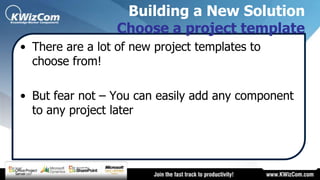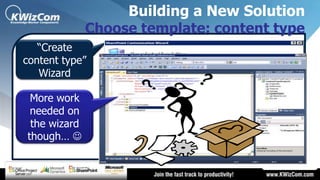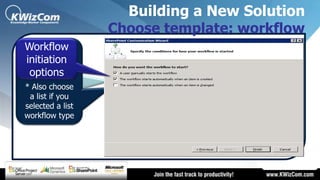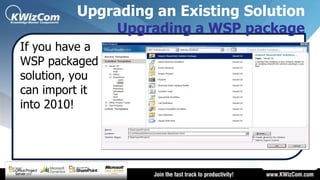Ad
Upgrading SLFE from 2007 to 2010
- 1. Philadelphia SharePoint CommunitySharePoint (2010 & 2007)
- 3. Developers
- 4. Architect Council after every meeting
- 5. Free Training before every meeting
- 6. www.TriStateSharePoint.com [coming in December]
- 7. Hosted blogs for members
- 9. Exclusive content / pre-release content
- 11. Free training
- 12. www.officegeeks.org/philly [until December]CONTACT: [email protected]: @tristateSPScheduled Speakers
- 13. Todd Bleeker
- 14. Rob Bogue
- 15. Eric Shupps
- 16. John Holliday
- 17. Ben Curry
- 18. Asif Rehmani
- 19. Paul Schaeflein
- 20. Brett Lonsdale
- 21. Nick Swan
- 22. (and more)
- 23. Topics
- 24. Upgrade to 2010
- 31. SharePoint Tools in Visual Studio 2010
- 32. Social Media
- 34. Workflows
- 35. Database and InfrastructureCase Study: Upgrading SLFE from 2007 to 2010Shai Petel ([email protected])VP R&D, Microsoft Certified TrainerKWizCom Corporation
- 36. ContentBuilding a new solutionUpgrading an existing solutionVersion management
- 37. GoalsIn this session you will learn about the new VS2010 extensions for WSSYou will learn how to migrate your existing solutions into the new environment reducing the migration process time to minimum.This session will allow you to make better decisions on your current solutions for 2007 today that will make the transition to 2010 easy and simple.
- 38. ContentBuilding a new solutionCreating a new solutionChoose a project templateSetup trust levelAdding new componentsOne-click deploy or packageUpgrading an existing solutionVersion management
- 39. Building a New Solution Before you begin…Is your team ready for 2010?Silverlight, Ajax, JSONVisual web parts! (or is it?)Prepare to be hosted!Limit customization to site collection levelPrefer to support sandboxed solutions*
- 40. Building a New Solution Before you begin…SharePoint web parts are still supported for backwards compatibility
- 41. Do not change base for existing web parts!!!Creating a new web part?Inherit from ASP.NET!
- 42. Building a New SolutionBefore you begin…
- 43. Building a New Solution Before you begin…Install all components on developer machine
- 44. Building a New Solution Before you begin…Install developer components on development client and use remote debugger to connect to development server (not so bad, but still…)
- 45. Building a New Solution Before you begin…Virtualize! (Recommended)
- 46. ContentBuilding a new solutionCreating a new solutionChoose a project templateSetup trust levelAdding new componentsOne-click deploy or packageUpgrading an existing solutionVersion management
- 47. Building a New SolutionCreating a new solutionOpen VS2010
- 48. Building a New SolutionCreating a new solutionClick on new project. Go to:C# -> SharePoint -> 2010 templates
- 49. ContentBuilding a new solutionCreating a new solutionChoose a project templateSetup trust levelAdding new componentsOne-click deploy or packageUpgrading an existing solutionVersion management
- 50. Building a New SolutionChoose a project templateThere are a lot of new project templates to choose from!But fear not – You can easily add any component to any project later
- 52. Building a New SolutionChoose template: visual web partThis project template cannot be sandboxed
- 53. Building a New SolutionChoose template: visual web partProject created with all web part files for you
- 54. Building a New SolutionChoose template: visual web partA feature will be created for you automatically
- 55. Building a New SolutionChoose template: visual web partA package will be created for you automatically
- 56. Building a New SolutionChoose template: event receiverThis project template can be sandboxed
- 57. Building a New SolutionChoose template: event receiver“Create project” WizardNew types of receiversNew events to handle!
- 58. Building a New SolutionChoose template: event receiverAdds all needed files for you
- 59. IntroducingBusiness Data Catalogue Tools
- 60. Building a New SolutionChoose template: BCS modelThis project template can be sandboxed
- 61. Building a New SolutionChoose template: BCS modelBCS editing tools
- 62. Building a New SolutionChoose template: BCS modelPackaged and deployed as a farm level feature
- 63. Building a New SolutionChoose template: content typeThis project template can be sandboxed
- 64. Building a New SolutionChoose template: content type“Create content type” WizardMore work needed on the wizard though…
- 65. Building a New SolutionChoose template: list definitionThis project template cannot be sandboxed
- 66. Building a New SolutionChoose template: list definition“Create List Def.” Wizard
- 67. Building a New SolutionChoose template: content typeSchema FileCreate Elements file for featureOptional: Create list instance XML
- 68. Building a New SolutionChoose template: content typePackaged and deployed as a web feature
- 69. Building a New SolutionChoose template: workflowThis project template cannot be sandboxed
- 70. Building a New SolutionChoose template: workflowSequential workflow is designed to execute a series of predefined steps to accomplish a certain taskState machine workflows are designed to work in event-driven scenarios. A state machine workflow contains two or more states, with one state being the active state at any given time
- 71. Building a New SolutionChoose template: workflow“State machine” wizardChoose history and tasks lists.* Also choose a list if you selected a list workflow typeWorkflow initiation options
- 72. Building a New SolutionChoose template: workflowDesigner has different options for site and list workflows
- 73. Building a New SolutionChoose template: workflowAdd sequential workflow, with its own designer
- 74. Building a New SolutionChoose template: workflowCreates separate elements file for each workflow
- 75. ContentBuilding a new solutionCreating a new solutionChoose a project templateSetup trust levelAdding new componentsOne-click deploy or packageUpgrading an existing solutionVersion management
- 76. IntroducingYour very own sandbox!
- 77. Building a New SolutionSetup trust levelChoose your destiny
- 78. Building a New SolutionSetup trust levelTo trust, or not to trust?Sandbox solutions is a way for you to deploy a set of features and components to your SharePoint site collection that will have no effect on other site collectionsSandbox solutions have limited support for extensibility and not all SharePoint customizations are allowedSandboxed solutions can be installed and deployed by site owner from site settings
- 79. Building a New SolutionSetup trust levelWhat does this setting change?This setting does not get written to WSP package, but will allow VS to validate your content is supported within a sandboxes solutionSolution assemblies within a sandboxed solution are not installed to GAC/Bin, and not running on W3WP process. Instead they run under SPUCWorkerProcessSandboxed solutions can be deployed as a full-trusted solution as well
- 80. Building a New SolutionSetup trust levelWhat is supported within a sandbox solution?List Definitions, List Instances, Content Types/FieldsWeb Parts (non visual)Event receivers: Item, List or WebDeclarative workflows, Custom Actions (Ribbon)Onet.xml, WebTemplate feature element (instead of Webtemp.xml) allows for site collection level site definitions!More…
- 81. Building a New SolutionSetup trust levelWhat is not supported within a sandbox solution?Mapped folders (14 hive)Some API will not work in sandboxed modeVisual Web PartsApplication PagesCustom Action GroupHideCustomAction elementWeb Application/Farm-scoped featuresWorkflows with code
- 82. Building a New SolutionSetup trust levelHow do I deploy a sandbox solution?Upload to Solutions galleryActivate
- 83. Building a New SolutionSetup trust levelCannot activate solution?Go to central administration and make sure windows SharePoint user code service is started
- 84. Building a New SolutionSetup trust levelKeep in mind:Deploying a sandbox solution automatically activates features within (unless specifically specified not to in the feature)To disable support for sandbox solutions simply stop the user code serviceUpgrading sandbox solutions are done manually site collection at a time
- 85. ContentBuilding a new solutionCreating a new solutionChoose a project templateSetup trust levelAdding new componentsOne-click deploy or packageUpgrading an existing solutionVersion management
- 86. Building a New SolutionAdding new componentsIt is extremely easy to add any component to any project you likeThis allows you to easily create more complex solutions that includes several types of customizations such as:Feature – for activationWeb parts – for visual UILists and list definitions for storing dataField types, event handlers, workflows and much more!
- 87. Building a New SolutionAdding new componentsAdd mapped folder
- 88. Building a New SolutionAdding new componentsAdd other components
- 89. ContentBuilding a new solutionCreating a new solutionChoose a project templateSetup trust levelAdding new componentsOne-click deploy or packageUpgrading an existing solutionVersion management
- 90. Building a New SolutionOne-click deploy or packageFeature and Package editors available
- 91. Building a New SolutionOne-click deploy or packageProject menu allows you to build, deploy to development server, and to package using a WSPBuild = compile code onlyPackage = compiles and builds the WSP packageDeploy = compile, package anddeploy the package (customizable!)Retract = removes the solutionpackage from server
- 92. ContentBuilding a new solutionUpgrading an existing solutionUpgrading a non-VSeWSS solutionUpgrading a 2005/2008 VSeWSS solutionUpgrading a WSP packageVersion management
- 93. Upgrading an Existing SolutionUpgrading an existing solution
- 94. ContentBuilding a new solutionUpgrading an existing solutionUpgrading a non-VSeWSSsolutionUpgrading a 2005/2008 VSeWSS solutionUpgrading a WSP packageVersion management
- 95. Upgrading an Existing SolutionUpgrading non-VSeWSS solutionCase study: Upgrading KWizCom SharePoint List Forms ExtensionsWhat we had in 2007:controltemplates ASCX files. New control templates and updating existing ones*Application settings pagesList settings linkFeature activated, MSI installerExternal references to utilities/shared resources
- 96. Upgrading an Existing SolutionUpgrading non-VSeWSS solutionSLFE version 1.*.*
- 97. Upgrading an Existing SolutionUpgrading non-VSeWSS solutionWhat we added in 2010:List settings ribbon buttonsAdd CSS file using DelegateWSP packaging
- 98. Live DemoSLFE ProjectLive demo of SLFE in Visual Studio 2010
- 99. Upgrading an Existing SolutionUpgrading non-VSeWSS solution2010 New UIRibbon (resizable)Using image store filesand CSS class
- 100. Live DemoSLFE SolutionLive demo of SLFE in SharePoint
- 101. Upgrading an Existing SolutionUpgrading non-VSeWSS solutionConclusionIn order to make the most of VS2010 and VS2010 extensions for WSS its best to build a new project skeleton and import existing code into it.If you already have a WSP package you can use it to build your project skeleton from it (reverse engineer) but your .NET code will not be included!
- 102. Upgrading an Existing SolutionUpgrading non-VSeWSS solutionSteps for upgrading a projectEstimated ~1 hour to 4 hours of 1 developer to have the solution ready for packaging.
- 103. ContentBuilding a new solutionUpgrading an existing solutionUpgrading a non-VSeWSSsolutionUpgrading a 2005/2008 VSeWSSsolutionUpgrading a WSP packageVersion management
- 104. Upgrading an Existing SolutionUpgrading 2005/2008 VSeWSSUnfortunately, you cannot convert VS2005/2008 projects using visual studio aloneTrying to do so will invoke this error:“The project type is not supported by this installation.”
- 105. Upgrading an Existing SolutionUpgrading 2005/2008 VSeWSSBut fear not! VSeWSS2010 comes with a conversion tool (VSeWSS 2008 only).For all other projects that used WSP for deployment - This next option might be what you are looking for!
- 106. ContentBuilding a new solutionUpgrading an existing solutionUpgrading a non-VSeWSSsolutionUpgrading a 2005/2008 VSeWSSsolutionUpgrading a WSP packageVersion management
- 107. Upgrading an Existing SolutionUpgrading a WSP packageIf you have a WSP packaged solution, you can import it into 2010!
- 108. Upgrading an Existing SolutionUpgrading a WSP packageImport wizardYour code doesnot getimported!
- 109. Upgrading an Existing SolutionUpgrading a WSP packageThe import process will build your skeleton for youAfter the import is done, some work is needed
- 110. Live DemoSLFE SolutionImporting WSP package
- 111. Upgrading an Existing SolutionImporting a WSP package
- 112. ContentBuilding a new solutionUpgrading an existing solutionVersion managementHow can I mark versionsShared resourcesUpgrade / downgrade solution version
- 113. Version ManagementVersion managementWhy do we need version management?Tractability of bugs or changesPerform upgrade operations on existing installations (add a field, create hidden list etc.)Monitor Dev, Staging and production deployment running codeNot for ISV only!In house development team? Get used to working with versioned packages!
- 114. ContentBuilding a new solutionUpgrading an existing solutionVersion managementHow can I mark versionsShared resourcesUpgrade / downgrade solution version
- 115. Version ManagementHow can I mark versionsCannot change assembly version!Currently no supportfor marking package,but you can markfeatures:Mark versionnumber in yourcode:
- 116. ContentBuilding a new solutionUpgrading an existing solutionVersion managementHow can I mark versionsShared resourcesUpgrade / downgrade solution version
- 117. Version ManagementShared resourcesYou may need to add shared resources to your projectsDLL’s (utility classes, base classes)Sandbox – no problemGAC – no problemBIN deployment – version collisions may occur.Shared resources (Images/CSS files)Use sub folders with utilities version number.For example:/_layouts/KWizCom_Shared_2.0.01
- 118. ContentBuilding a new solutionUpgrading an existing solutionVersion managementHow can I mark versionsShared resourcesUpgrade / downgrade solution version
- 119. Version ManagementUp/downgrade solution versionBuilt in support for upgrade operations!SharePoint will allow mark if feature requires upgradeMany upgrade operations supported, and custom upgrade handlers can be coded
- 120. Version ManagementUp/downgrade solution versionUpgrading / downgrading is easy!Once you deploy several versions of same solution you will be able to upgrade instead of activate!
- 121. ContentBuilding a new solutionUpgrading an existing solutionVersion management
- 122. SummaryYou now have real-world experience in upgrading components into 2010There is a lot more to seeCome visit us at our booth for more information and for 1 on 1 talks!Overall, It’s been a pleasure!
- 123. Contact UsFor more information on SharePoint 2010 please don’t hesitate to contact us!At our booth out side
- 126. Blog: http://kwizcom.blogspot.com* Learn * Plan * Deploy * Build *Call to learn how KWizCom can assist you!
- 127. Learn More about SharePoint 2010Information forIT Prosat TechNethttp://MSSharePointITPro.comInformation forDevelopersat MSDNhttp://MSSharePointDeveloper.comInformation forEveryonehttp://SharePoint.Microsoft.com
- 128. KWizComContact:Shai Petel ([email protected])VP R&D, Microsoft Certified TrainerKWizCom Corporation
Editor's Notes
- #2: Upgrading Philly Office Geeks in DecemberWorld-class speakersFocus on SharePoint 2010 and 2007Jump start Philly SharePoint communityRegional focus – looking into different meeting locations/optionsInvestigating various virtual meeting options
- #3: This is my personal experience upgrading SLFE from 2007 to 2010.(what will be different in my presentation is that it is based on actual migration I did and the lessons I learned, hope it can save you some time and allow to you take the right decisions on your projects today that will prepare you for the future)
- #4: These are the topics…1st quick overview on VSeWSS2010, allow us to prepare for the next topic, which is the main one…Last – versioning, my personal goal to make all my customer work like an ISV
- #6: * Sandbox See below
- #7: 2 clicks
- #9: Farm level resources:SQL, file system, 14 hive, schema filesEasy to mess up:Developer has full control and can make his environment. Unusable and cannot revert it back to original form.Hard to backup:Server, not code. For code we use VSS.New: Supported under windows 764bit for developers!!!
- #11: No worries environment:(can restore to original state with no problems so feel free to mess up the server!
- #13: 1 click
- #16: You will need to decide what type of project you wish to create.(Visual web part, list/site definition, event handler, workflow, BCS and much more)If you are not sure you can start with an empty one.For advanced solutions that has many different customizations (web parts, list definitions and more…) just pick any project and add other components to it after you create the project.
- #19: Files:CS file for web partASCX and ASCX.CS file for user control*.webpart XML fileElements XML file for use in featuresNote: All web part related files are created within the same folder to help you keep resources organized.4 clicks
- #20: Note:New feature designer!The elements file from within the web part is recognized and added into your feature.
- #21: Note:New package designer!All features and elements in this projectare recognized and added into your package.1 click
- #23: When creating this type of project there is a wizard to guide you through the creation of the solution.Note: new types of event receivers.Note: New events to handle in existing event receivers!2 clicks
- #24: Elements file within the receiver’s folder to be used in features.Receiver’s handler code file.1 Click
- #27: BCS – Business connectivity Services (former BDC)1 click
- #28: 1 Click
- #30: Just intelli-sense… no real wizard.2 Clicks
- #32: no real wizard. But creates all files for you (list def, feature elements, and list instance)
- #33: 2 clicks
- #34: no real wizard. But creates all files for you (list def, feature elements, and list instance)
- #38: 1 click
- #39: 1 Click
- #45: 1 Click
- #47: Deploying a sandbox solution that has any of the forbidden content will succeed but that content will not be deployed.Application pages: no pages into layouts since no mapped folders.Pages with embedded code are not supported from data base – security.
- #53: 1 click
- #54: 1 click
- #56: 1 click
- #57: 1 click
- #60: Updating existing ones done using file system priority trick still working in 2010.We used MSI installer due to some limitations in WSP
- #61: 1 Click
- #62: All in XML,Added images, CSS and ASCXShow live, visual studio
- #63: Show the upgraded componentsShow the new components
- #64: Show live
- #65: Show the new Ribbon UI, and shot settings pagesShow it working in the new item popupShow next / prev item based on view in tasksShow groupingShow disabled field
- #66: 2 Clicks
- #68: 1 Click
- #69: 1 Click
- #71: Note: code does not get imported.3 clicks
- #72: After import is done – still need to import code manually and set namespace / assembly evidence
- #73: Import SLFE WSP package,Show what is created (skeleton),Manually add code files and set namespace, assembly evidence.
- #75: Pages, web parts, event handlers – do not support assembly version changes.Version in features for upgrade operations if needed. Change only when needed.Version in code, to show in about to identify current running version easily. Change every time.
- #76: 2 clicks
- #78: 1 click after auto
- #79: Overall, my personal experience was very positive,The beta is in great shape and migrating customizations looks simple.






![www.TriStateSharePoint.com [coming in December]](https://image.slidesharecdn.com/shaipetelsharepointsaturdayphilly-091117102521-phpapp01/85/Upgrading-SLFE-from-2007-to-2010-6-320.jpg)





![www.officegeeks.org/philly [until December]CONTACT: tss@mannsoftware.comTWITTER: @tristateSPScheduled Speakers](https://image.slidesharecdn.com/shaipetelsharepointsaturdayphilly-091117102521-phpapp01/85/Upgrading-SLFE-from-2007-to-2010-12-320.jpg)








































































































































